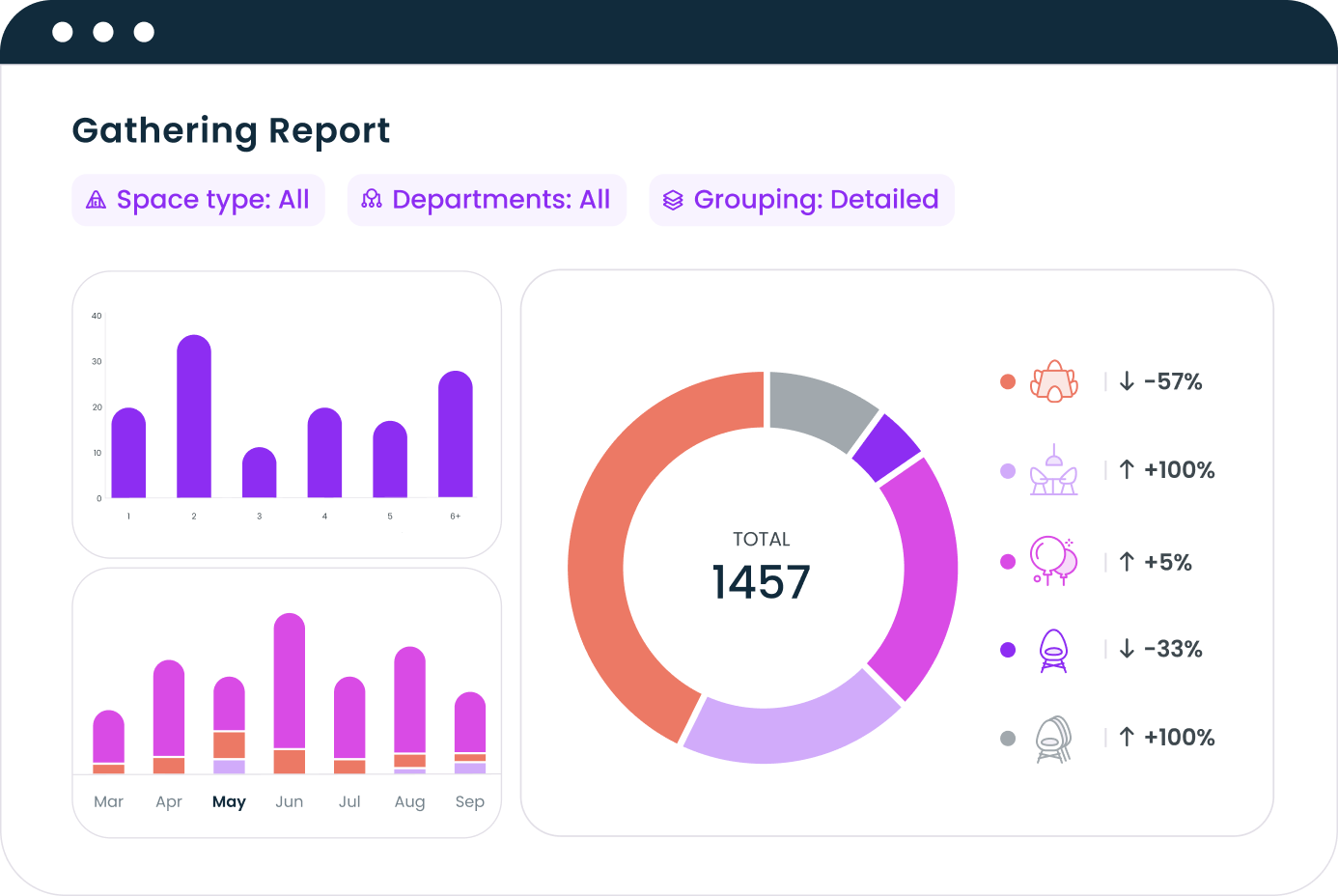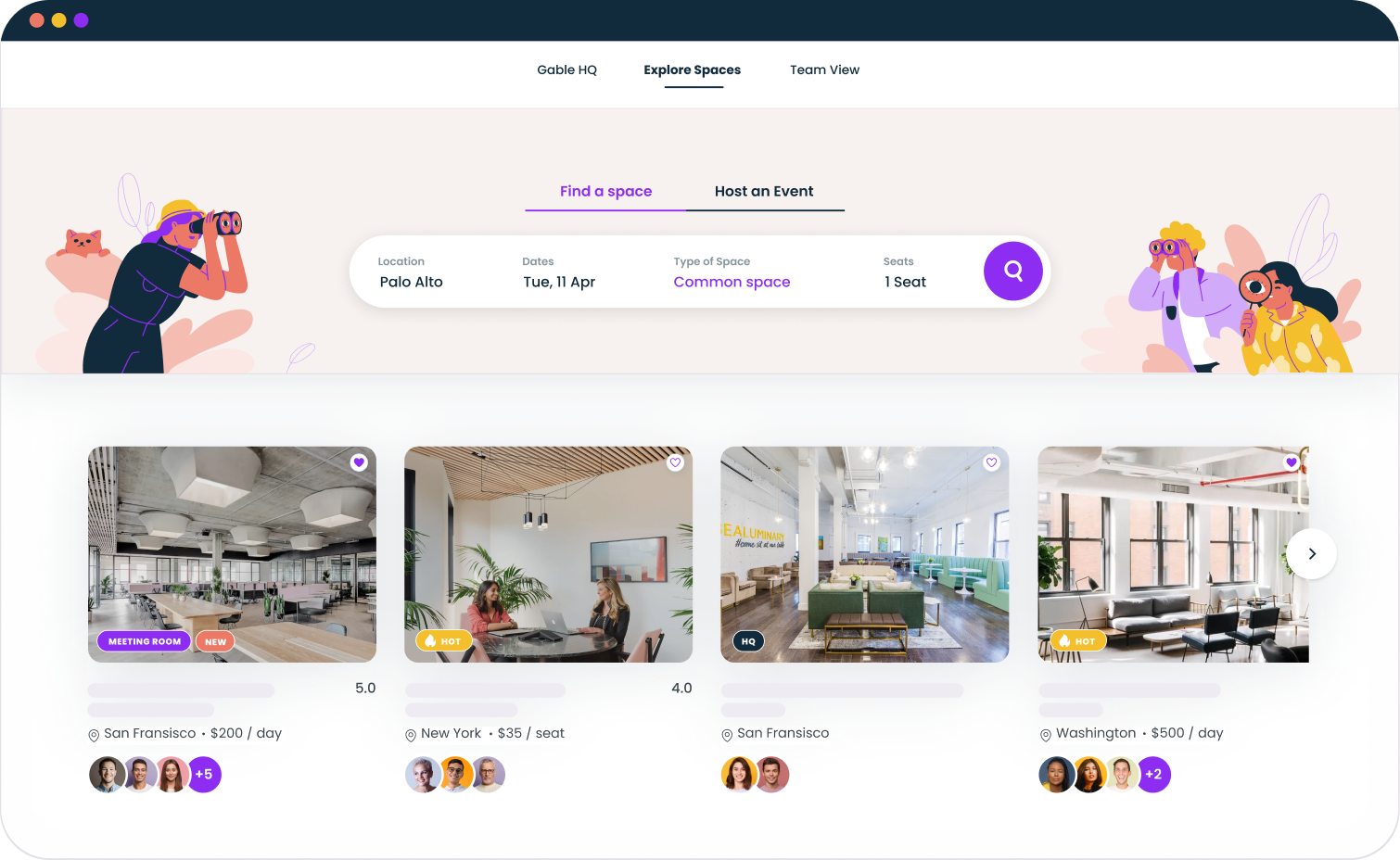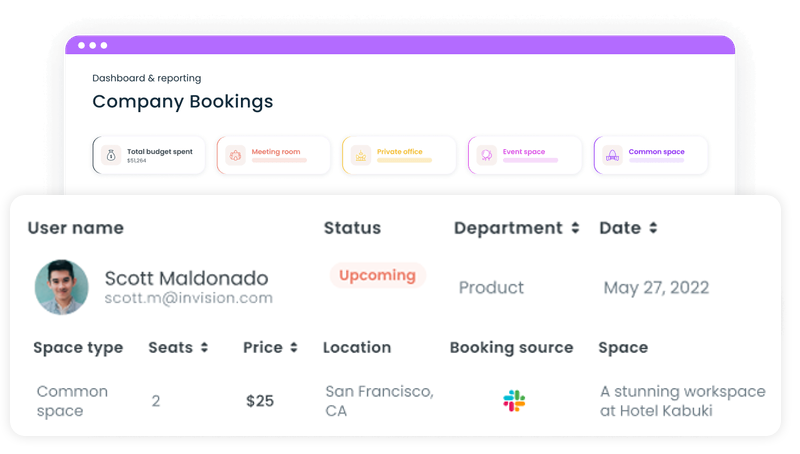Flexible office space is transforming how businesses operate. The flexible office market is projected to reach $136.46 billion by 2032 with a 17.08% annual growth rate. With office utilization hovering at just 40% globally and hybrid work becoming the standard, businesses are discovering that flexible workspace solutions offer the adaptability and cost efficiency needed to thrive in today's dynamic work environment.
What is flexible office space?
Flexible office space refers to workspace solutions that provide businesses with adaptable, fully-equipped work environments without the constraints of traditional office leases. Unlike traditional offices, where companies commit to a fixed office footprint for years, flexible workspace solutions offer everything from hot desks and private office spaces to virtual office services and conference rooms on flexible contracts.
The flexible workspace industry encompasses several distinct offerings:
Coworking spaces provide shared collaborative spaces where professionals work alongside each other in open-plan desk layouts. These shared spaces typically include amenities like coffee bars, high-speed internet, and networking opportunities with other businesses.
Private office solutions offer dedicated workspace for teams requiring minimal disruption while maintaining flexible memberships and shorter lease terms than traditional offices.
On-demand workspaces enable employees to book a perfect workspace as needed, from quiet corners for focused work to conference rooms for brainstorming sessions and team collaboration.
Virtual office services provide business address solutions for remote work scenarios, allowing businesses to maintain a professional presence without physical office space.
The fundamental aspect differentiating flexible space from traditional office space is the ability to adapt quickly to changing business needs while providing employees with workspace variety, supporting different work styles.
The growth of flexible workspace solutions
The global flexible office market, valued at $39.57 billion in 2024, is projected to reach $136.46 billion by 2032, exhibiting a remarkable 17.08% compound annual growth rate. In North America, the market reached $14.90 billion in 2025 and is expected to grow to $28.94 billion by 2030.
Several factors drive this growth:
Hybrid work adoption: With 92% of corporate occupancy choices steered by hybrid policies, companies are reallocating 10-50% of their portfolios to flexible spaces. Current utilization rates hover between 60% and 85% of 2019 benchmarks, making long leases less efficient.
Employee expectations: 74% of employees consider flexible work arrangements non-negotiable, forcing companies to provide workspace options supporting both collaboration and individual productivity.
Cost effectiveness: Employers can save around 50% on office space costs by adopting hybrid work models that incorporate flexible workspace solutions.

Get our step-by-step guide to evaluating flexible workspace options, comparing costs, and selecting solutions that match your business needs.
Read the guide
Types of flexible office solutions
Coworking spaces
Coworking spaces represent 53.2% of the flexible office market revenue, providing a shared work environment with professional amenities. These collaborative spaces offer open workstations, meeting rooms, phone booths, and shared workspaces designed for productivity and well-being.
Modern coworking spaces combat remote work isolation and improve work-life balance while providing networking opportunities. For distributed teams, they serve as neutral meeting grounds where remote employees gather for in-person collaboration without permanent office commitments.
Comprehensive flexible workspace strategies help companies maximize coworking benefits while maintaining operational efficiency and cost control.
Private office and dedicated desks
Private office spaces within flexible workspace providers offer a dedicated work environment with flexible lease terms. Unlike traditional office leases requiring years-long commitments, these solutions typically offer terms from one month to two years.
Private office configurations accommodate teams from solo entrepreneurs to 50+ people, with a customizable layout that reflects the office culture. These spaces include access to meeting rooms, event space, and shared facilities while providing security and branding opportunities.
On-demand workspace booking
The on-demand model allows employees to book space exactly when needed. This approach benefits hybrid teams coming together periodically while maintaining distributed work patterns.
Gable's On-Demand platform provides access to 14,000+ premium workspaces across 600 cities worldwide, enabling companies to support employees wherever business takes them. Whether employees need a quiet area for client calls, conference rooms for presentations, or a collaborative space for project work, on-demand solutions provide professional workspace without ongoing facility management.
Benefits of flexible office space for modern businesses
Dramatic cost reduction and financial agility
Traditional office leases represent 10-15% of operating expenses with substantial hidden costs. Flexible workspace solutions reduce total costs by 30-50% while eliminating capital expenditure for office fit-outs, furniture, and equipment.
The financial transformation goes beyond rent savings. Unlike traditional offices, which require separate contracts for utilities, cleaning services, internet, and maintenance, flexible spaces bundle everything into predictable monthly fees. Companies avoid $50,000-$200,000 upfront costs while gaining the ability to optimize office space utilization based on actual usage rather than fixed commitments.
Understanding cost-effective flexible workspace strategies enables businesses to redirect capital from real estate waste toward growth initiatives, technology investments, and employee benefits that drive competitive advantage.
Enhanced productivity through workspace choice
Research shows hybrid employees achieve 35% engagement rates compared to 27% for in-office employees. Flexible workspace environments support various work styles through diverse environments that employees choose based on immediate needs.
The productivity boost stems from environmental alignment with work tasks. When employees access quiet areas for focused work, collaborative zones for team projects, or professional meeting rooms for client interactions, they perform significantly better than in assigned desks with limited options.
Effective workspace management amplifies these benefits by providing data insights into space utilization patterns, enabling companies to optimize office layouts for maximum employee productivity and satisfaction.
Strategic business agility and growth enablement
Flexible workspace solutions enable businesses to adapt quickly without traditional real estate constraints. Companies can expand into new markets, accommodate team size fluctuations, or pivot during economic uncertainty without renegotiating expensive leases or paying termination penalties.
This agility proves invaluable for rapid growth scenarios and market testing. Instead of overcommitting to fixed office footprints based on uncertain projections, businesses scale workspace access based on actual demand while implementing flexible work arrangements that attract top talent.
The strategic advantage extends to competitive positioning. Companies using flexible workspace can enter new markets faster, respond to opportunities quicker, and maintain operational efficiency during business transitions that would otherwise require costly real estate adjustments.
Give your team instant access to flexible office spaces in 600+ cities with Gable On-Demand - no contracts, just professional workspace when you need it.
Learn more
Supporting hybrid work models
Flexible workspace solutions address hybrid work requirements that traditional offices struggle to meet, providing essential infrastructure for successful hybrid work implementation.
Bridging remote and in-person collaboration
Hybrid work requires seamless transitions between remote and in-person collaboration. Flexible workspaces provide technology-enabled environments supporting both virtual and face-to-face interactions through advanced video conferencing, digital whiteboards, and collaboration tools.
Space variety within flexible environments supports different collaboration needs. Teams move from open areas for brainstorming to private meeting rooms for sensitive discussions, often within the same booking arrangement.
Accommodating fluctuating space needs
Hybrid work patterns create unpredictable space demands that traditional offices cannot efficiently accommodate. Some days require extensive collaboration space for team meetings, while others see minimal utilization.
With office utilization averaging 40% globally, flexible workspace solutions align costs with actual usage through on-demand booking and scalable space options rather than maintaining fixed office space sized for peak usage.
Cost comparison: Flexible vs traditional office
Direct cost analysis
Traditional office leases involve substantial upfront costs, including security deposits (3-6 months' rent), legal fees, furniture procurement, and technology infrastructure, often $50,000-$200,000 before employees even begin working.
Ongoing operational expenses include utilities, maintenance, cleaning services, security, and insurance, adding 20-30% to base rent with administrative overhead.
Flexible workspace solutions bundle these costs into a single monthly fee, including workspace access, utilities, cleaning, maintenance, high-speed internet, and basic amenities. While per-desk costs may appear higher, the all-inclusive nature often results in cost savings.
Hidden cost considerations
Traditional arrangements involve numerous hidden costs: unused space (with 40% utilization), inflexibility during economic changes, and opportunity costs from capital tied up in deposits and fit-outs.
Companies like Checkr reduced workplace costs by 51% while ensuring employees had access to high-quality workspaces through flexible solutions.
Implementation strategies
Location and space requirements
Successful flexible workspace selection requires evaluating employee distribution, transportation links, and neighborhood amenities. Consider whether locations accommodate business growth and changing geographic requirements.
Different work activities require different environmental supports. Evaluate collaboration requirements, focus work needs, client interaction spaces, and technology requirements when selecting workspace solutions.
Technology and booking systems
Modern flexible workspaces compete on technology infrastructure quality. Assess internet reliability, printing services, security measures, and the flexibility of the booking system to accommodate changing requirements.
Effective space management provides real-time insights, seamless scalability, and flexibility needed to thrive in hybrid environments.
Market trends and future outlook
Regional growth patterns
Workplace utilization increased 9 points year-over-year to 40% globally, suggesting stabilization at new normal levels. Regional variations show different recovery patterns:
- North America: 26.5% average utilization with encouraging improvement signs
- UK: 51.5% utilization, highest globally
- APAC: 39% utilization with dramatic year-over-year improvement
Industry adoption trends
Flexible office demand increased 13% in the first half of 2024, with large companies utilizing varied forms. Requirements for 26+ desks comprise 30% of inquiries, while meeting room searches increased 75%.
45% of coworking spaces are now in suburban neighborhoods, serving hybrid workers preferring locations closer to home while maintaining professional office environments.
Creating effective workspace strategies
Policy development
Successful hybrid work requires clear policies outlining in-office expectations, meeting guidelines, and workspace booking systems. Learn how to develop comprehensive hybrid work policies that balance flexibility with structure while maximizing employee engagement.
Creating effective flexible work environments requires strategic planning that considers employee preferences, business objectives, and operational efficiency for long-term success.
Space optimization
Understanding space utilization patterns enables data-driven decisions about workspace allocation, peak usage times, and space type requirements for optimal hybrid work environments.
Companies must measure space usage, peak office days, and meeting room demand to optimize layouts, ensuring employees have access to the right spaces at the right times.
Get access to premium flexible workspaces worldwide, reduce costs, and enhance employee experience. Discover how Gable can help optimize your business operations.
Get a demo





.svg)





.svg)

























